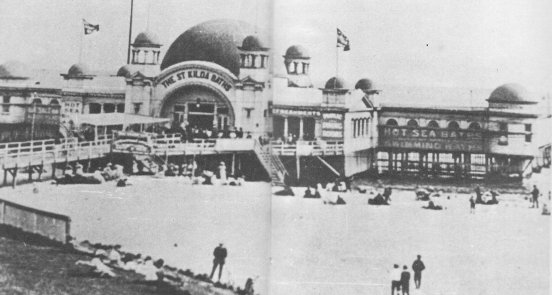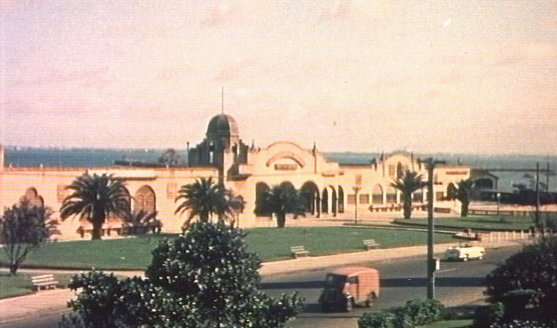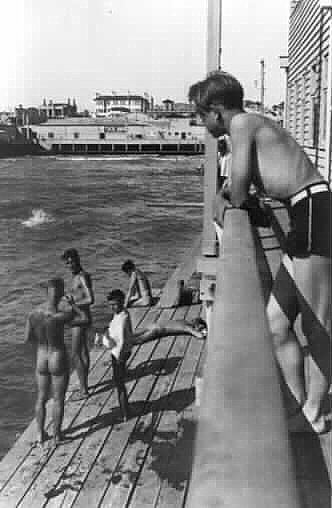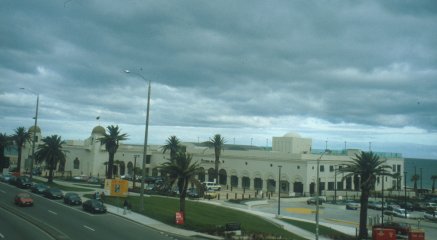|
|
|
Home | Introduction | Contents| Feedback | Map | Sources | Glossary |
|
2
St Kilda Sea Baths
After the 1850s, sea bathing became acceptable, but within large timber structures protective from predatory marine life, but more so protective from the popular gaze. Women were protected from the sight of men bathing because men frequently bathed naked. Sea-bathing was popular as a health tonic. Throughout the nineteenth century, there were as many as six different sea baths operating along the St Kilda shore, giving St Kilda it’s reputation for therapeutic sea air, ozone and ‘a dip in the briny’. The prohibition of Sunday bathing was first challenged in 1912 by the Open Sea Bathers’ League who dared to enter the water and were not arrested. Yet St Kilda Council’s bye-law was not revoked until 1922, by which time thousands of bathers, including Methodists, had broken it.
In 1854, Captain Kenney bought the Nancy, one of many ships abandoned by
crews deserted for the goldfields. It was beached and scuttled south of St
Kilda Pier. He ran a line to shore to guide bathers out to the ship, self
propelled by dinghy. He and his family lived aboard. He also operated ladies’
baths at St Kilda, advertised as under the ‘personal superintendence of
Mrs Kenney and the Misses Kenney’, with swimming
tuition by Miss Elphinstone Dick. A special return
rail fare from
St Kilda Baths, c.1915 An 1856 select committee of the Legislative Council of Victoria recommended the establishment of a Sea Bathing Company at St Kilda of two bathing houses. Construction commenced in 1858 and the baths at ‘sparkling St Kilda by the sea’ opened in 1860. They included gymnasium, refreshment rooms, residence, and offices and a 234 by 61 metre swimming enclosure. Bathers formed a club ‘Companions of the Baths’ of which much later, Zelman Cowen was a member. Extension of the tramline ‘to the very doors of the bathing establishments’ in 1925 increased their popularity, but after dark, gaslight made ‘the blackness of the water more apparent and repulsive’. By 1925, bathing in sea-baths was less popular: people braved the open sea. Eventually, there were at least four separate enclosures. The last, in 1903, was the most exotic with domical clusters overhead and hot sea baths. Alas it was destroyed by fire in 1926. The fifth, the Kenney bathing ship survived until 1912.
In 1917, open sea bathing was legalised and 10 years
later the sexes were mingling freely in the water. So, in 1928 Council erected
three open-sea pavilions (changing sheds): at Beaconsfield Parade, at
St Kilda Sea Baths, c.1950
The women’s section had Islamic fretwork screens and Moorish domical towers
which echo the pairs of domical towers at the Palais,
at
Yet it appears no architect was involved. It was designed in 1929 by the City
Engineer’s Department of St Kilda Council. The City Building Surveyor was
Richard Terence who held a certificate in engineering. The new sea baths were
no flimsy timber structure, but spacious and solid. In anticipation of its
expected popularity, 756 lockers were provided for men and 572 for women. The
only comparable structures in
It remained
Standards of acceptable ‘decency’ and dress at the baths were vigorously debated. In 1938 ‘mixed’ bathing of both sexes, legal since 1927, was restricted to weekends and only in the ladies’ section. However, during World War II (1939-45) relaxed moral standards allowed nude sunbathing. 1945 is also the moment when Sidney Nolan, living in St Kilda, was painting the beach and in works such as Bathers and St Kilda, the Sea Baths. Several figures appear to be sunbathing nude in this picture.
Nude Bathers in Men's Section, c.1945
The building also deteriorated due to lack of maintenance and by 1950, the wings of the baths which stretched east to sea were considered unsafe and closed. The council’s lease expired in 1953. In 1955, the government signed a new lease with South Pacific Holdings. They demolished the deteriorated men’s baths and the decorative parapets, closed the toilets and repaired the women’s section. A sequence of night-clubs operated in the former domed café, including Leonards, named for the family who co-managed the place, with F.C. Carroll. In the 1970s one of the most infamous of these clubs was Bojangles. It was notorious for its violence and several deaths. In 1981, the Sea Baths’ concrete wings were demolished. By the mid-1980s, the only operative lease was for the hot Sea Baths which was surrounded by derelict structure. The night-club had closed and the former café, victim of fires and vandalism. In 1985, the adjacent St Kilda Pier was rebuilt, but redevelopment of the Sea Baths was not discussed until 1989. In late 1991 the Joan Kirner state government sought redevelopment proposals for the site. Hannah Friedman of Zarawaters was selected as the preferred developer of cafés, function room, health club and pool. In 1993 the Sea Baths closed. Three years were absorbed by planning process. In May 1995 construction commenced by demolition of the building except the two copper domes. Zarawaters was prosecuted in the Administrative Appeals Tribunal for illegal building works, which were then required to be demolished. In 1997 the contractors, Fletcher Construction took legal action against Zarawaters and work stopped again. In April, a petition with 500 signatures demanded that the new building be demolished. Both the Premier, Jeff Kennett and Mayor Dick Gross supported demolition. Later in the year, Castlepines of Sydney sought to take over the lease, but did not proceed. In 1998, Zarawaters appointed new directors and changed its name to St Kilda Sea Baths Pty. Ltd, but by October, receivers had been appointed.
St Kilda Sea Baths, 2002 By the end of the year, Dr Henry and Jannie Tay of Singapore bought the lease, renamed the project South Pacific St Kilda and a 460 space, three-level car park was added to the project at an additional $15 million cost. In early 2000, construction of the car park began and a new design for the complex received planning approval. A year later the Deputy Premier John Thwaites officially opened the $55 million, 10,000 square metre pool complex, but without the pool. Hepburn Spa Resort was engaged to operate the complex. Since then the various components have been incrementally opened, including the pool, in October 2001.
Lynn,
Elwyn. Sidney Nolan -
Emerald Hill Times
- The
Kelly,
Jan. ‘Still not making a splash’. Herald Sun.
Kelly,
Jan. ‘Opening sinks delay claims’. Herald Sun.
Kenneth, Joachim.
‘Skinny Dipping in Style’. The
Herald.
Kerrick, Jane. ‘Surf still not up at sea baths’. Port Philip/ Caulfield Leader. 28 May 2000.
National Trust of
Robert Peck von Hartel Trethowan. City of St Kilda Twentieth Century Architectural Study. May 1992. Vol.3. Sidney
Nolan. Bathers. 1945. Collection of
Sidney Nolan. St Kilda. 1945. Oil. Niagra Galleries.
Splash. St
Szego, Julie. ‘False start: the sea baths saga continues’.
The Age.
Wells,
Lana. Sunny Memories.
Australians at the
|
|
St Kilda Historical Society Inc. © 2005 |




